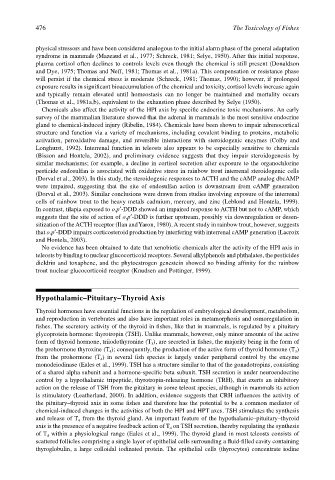Page 496 - The Toxicology of Fishes
P. 496
476 The Toxicology of Fishes
physical stressors and have been considered analogous to the initial alarm phase of the general adaptation
syndrome in mammals (Mazeaud et al., 1977; Schreck, 1981; Selye, 1950). After this initial response,
plasma cortisol often declines to controls levels even though the chemical is still present (Donaldson
and Dye, 1975; Thomas and Neff, 1981; Thomas et al., 1981a). This compensation or resistance phase
will persist if the chemical stress is moderate (Schreck, 1981; Thomas, 1990); however, if prolonged
exposure results in significant bioaccumulation of the chemical and toxicity, cortisol levels increase again
and typically remain elevated until homeostasis can no longer be maintained and mortality occurs
(Thomas et al., 1981a,b), equivalent to the exhaustion phase described by Selye (1950).
Chemicals also affect the activity of the HPI axis by specific endocrine toxic mechanisms. An early
survey of the mammalian literature showed that the adrenal in mammals is the most sensitive endocrine
gland to chemical-induced injury (Ribelin, 1984). Chemicals have been shown to impair adrenocortical
structure and function via a variety of mechanisms, including covalent binding to proteins, metabolic
activation, peroxidative damage, and reversible interactions with steroidogenic enzymes (Colby and
Longhurst, 1992). Interrenal function in teleosts also appears to be especially sensitive to chemicals
(Bisson and Hontela, 2002), and preliminary evidence suggests that they impair steroidogenesis by
similar mechanisms; for example, a decline in cortisol secretion after exposure to the organochlorine
pesticide endosulfan is associated with oxidative stress in rainbow trout interrenal steroidogenic cells
(Dorval et al., 2003). In this study, the steroidogenic responses to ACTH and the cAMP analog dbcAMP
were impaired, suggesting that the site of endosulfan action is downstream from cAMP generation
(Dorval et al., 2003). Similar conclusions were drawn from studies involving exposure of the interrenal
cells of rainbow trout to the heavy metals cadmium, mercury, and zinc (Leblond and Hontela, 1999).
In contrast, tilapia exposed to o,p′-DDD showed an impaired response to ACTH but not to cAMP, which
suggests that the site of action of o,p′-DDD is further upstream, possibly via downregulation or desen-
sitization of the ACTH receptor (Ilan and Yaron, 1980). A recent study in rainbow trout, however, suggests
that o,p′-DDD impairs corticosteroid production by interfering with interrenal cAMP generation (Lacroix
and Hontela, 2003).
No evidence has been obtained to date that xenobiotic chemicals alter the activity of the HPI axis in
teleosts by binding to nuclear glucocorticoid receptors. Several alkylphenols and phthalates, the pesticides
dieldrin and toxaphene, and the phytoestrogen genestein showed no binding affinity for the rainbow
trout nuclear glucocorticoid receptor (Knudsen and Pottinger, 1999).
Hypothalamic–Pituitary–Thyroid Axis
Thyroid hormones have essential functions in the regulation of embryological development, metabolism,
and reproduction in vertebrates and also have important roles in metamorphosis and osmoregulation in
fishes. The secretory activity of the thyroid in fishes, like that in mammals, is regulated by a pituitary
glycoprotein hormone: thyrotropin (TSH). Unlike mammals, however, only minor amounts of the active
form of thyroid hormone, triiodothyronine (T ), are secreted in fishes, the majority being in the form of
3
the prohormone thyroxine (T ); consequently, the production of the active form of thyroid hormone (T )
4
3
from the prohormone (T ) in several fish species is largely under peripheral control by the enzyme
4
monodeiodinase (Eales et al., 1999). TSH has a structure similar to that of the gonadotropins, consisting
of a shared alpha subunit and a hormone-specific beta subunit. TSH secretion is under neuroendocrine
control by a hypothalamic tripeptide, thyrotropin-releasing hormone (TRH), that exerts an inhibitory
action on the release of TSH from the pituitary in some teleost species, although in mammals its action
is stimulatory (Leatherland, 2000). In addition, evidence suggests that CRH influences the activity of
the pituitary–thyroid axis in some fishes and therefore has the potential to be a common mediator of
chemical-induced changes in the activities of both the HPI and HPT axes. TSH stimulates the synthesis
and release of T from the thyroid gland. An important feature of the hypothalamic–pituitary–thyroid
4
axis is the presence of a negative feedback action of T on TSH secretion, thereby regulating the synthesis
4
of T within a physiological range (Eales et al., 1999). The thyroid gland in most teleosts consists of
4
scattered follicles comprising a single layer of epithelial cells surrounding a fluid-filled cavity containing
thyroglobulin, a large colloidal iodinated protein. The epithelial cells (thyrocytes) concentrate iodine

